Shodhana Sneha: Meaning, Purpose, How to Administer
Article by Dr Raghuram Y.S. MD (Ay) & Dr Manasa S, B.A.M.S
Meaning and Purpose – Sneha is administered for many purposes. Sneha administered for the purpose of shodhana – purification / cleansing is known as Shodhana Sneha. It is also called Shodhananga Sweda. It is one among the three kinds of Snehana explained by Master Vagbhata based on their action.
Reference – Ashtanga Hridaya Sutra Sthana Chapter 16, Verses 19-22
Table of Contents
Shodhana Sneha
ह्यस्तने जीर्ण एवान्ने स्नेहोऽच्छः शुद्धये बहुः।
Shodhana Sneha, as already mentioned, is administered with the purpose of Shodhana – cleansing the body.
It includes the Sneha used in large quantities for preparing the patient for Panchakarma procedures, mainly vamana – therapeutic emesis and virechana – therapeutic purgation.
Vamana and Virechana are important Shodhana therapies which are beneficial for cleansing the body of the morbid doshas – kapha and pitta. But before administering vamana or virechana, the person should be prepared well for undergoing these procedures. Snehana and Swedana form the important purvakarmas – preparatory procedures for these shodhana therapies.
The snehana used for preparing the patient for vamana or virechana is called shodhana Sneha. So, shodhana Sneha is a purvakarma – preparatory procedure for conducting shodhana, mainly vamana and virechana.
Rules and Regulations for Shodhana Sneha
Achcha Sneha i.e. only fat
That Sneha which is not mixed with any other thing / food substances should be given for drinking, in the case of Shodhana Sneha.
Bahu Sneha
Sneha should be given in large quantities i.e. maximum dosage. The quantity should be large or maximum because the body of the patient needs to be saturated with Sneha and for that large quantities of Sneha are administered. The dose should be such that it would get digested in a time span of eight yamas i.e. 24 hours. The same dose is divided across three to seven days by which the saturation of the body with Sneha is expected to happen.
Hyastane Jirna eva Anne
Shodhana Sneha should be administered only and soon after the previously digested food has been digested. To be precise, this high dose of Sneha should be given on an empty stomach, early in the morning, after having assessed that the food consumed the previous night has been properly digested, which can be known by presence of signs of proper digestion of food and absence of signs of indigestion. After confirming this, shodhana Sneha is administered.
Shodhana Sneha, Agni and Hunger
At this point, the person should not only have an empty stomach, but also should not have hunger. One is hungry only when the agni is active. If the agni is active, the shodhana Sneha is exposed to the fiery action of agni and would get digested. That would nullify the effect of the medicine. So, shodhana Sneha should be administered before the agni becomes active and should not be let into contact with agni. Only then can we tap maximum therapeutic benefits from Shodhana Sneha, else it would act like Shamana Sneha.
Other points of interest about Shodhana Sneha
Should the entire quantity of Sneha be administered at a time?
No. Sneha used for Shodhana purpose is given in Arohana Krama i.e. gradual increasing dosage for three to seven days. Every day the dose of Sneha is increased until the point of saturation is achieved.
It is from this ‘number of days required for saturation of the body with sneha’ perspective that the number of days required to obtain signs of proper snehana – Samyak snigdha lakshanas that the maximum dose differs from person to person and also the number of days required for saturation.
How to know that the body and the tissues have been saturated with Sneha?
When the body and its tissues become completely saturated with Sneha and that too in proper way, ‘samyak snigdha lakshanas’ i.e. ‘signs of proper oleation’ occur. This is also an indicator that snehana should be stopped. This is also an indicator that the Sneha has been administered in a proper way, in the proper dose.
Samyak Snigdha Lakshanas
वातानुलोम्यं दीप्तोऽग्निर्वर्चः स्निग्धमसंहतम्॥३०॥
– Vatanulomanam – downward movement of vata
– Agni dipti – digestive fire getting kindled
– Varchah snigdham asamhatam – feces stained or admixed with Sneha – unctuous material and unformed – not solid
– Sneha udvega – aversion towards fat
– Klama – exhaustion
Mode of action of Shodhana Sneha
Shodhana Sneha, after getting absorbed and put into circulation, reaches the tissues. On entering the cells, it would bulge the tissues and also get admixed with doshas and malas therein.
When Swedana is administered as the next part of preparation, the heat of swedana opens up the cellular openings through which the Sneha, along with the doshas and malas melt down and liquify, exit the cells and flow towards the kostha – gut.
Once the doshas reach the kostha, they are removed from the body by administering vamana or virechana.
Without Sneha being given in Shodhana form of dosage, the doshas in the cells would never come back to the kostha and can never be removed from the body.
Therefore, Shodhana Sneha and Swedana form an effective combo and mandatory preparatory therapies for administration of shodhana, mainly vamana and virechana.
Summary of Shodhana Sneha
In short, below mentioned are the features of Shodhana Sneha –
– It is administered with the purpose of expelling the doshas from the body
– It is administered in maximum / large doses, after the previously taken food has been digested.
– It is administered on an empty stomach when the person is not hungry.
– It is administered in case of severely aggravated doshas and very strong diseases.
– It is administered for 3 to 7 days in Arohana Krama, until Samyak Snigdha Lakshanas are obtained. After these signs are observed, snehapana is stopped and Swedana – sudation is administered.
– Along with Swedana, Shodhana Sneha is an important and mandatory part of Purvakarma for Shodhana, mainly vamana and virechana therapies.









